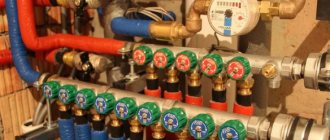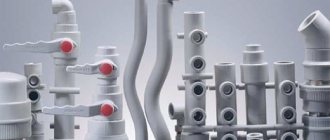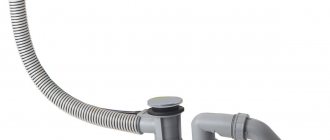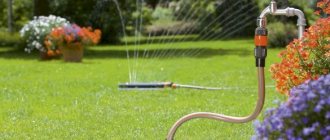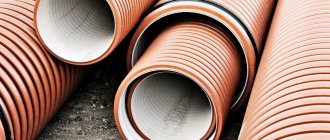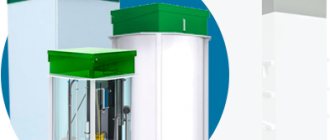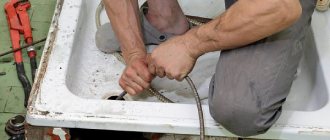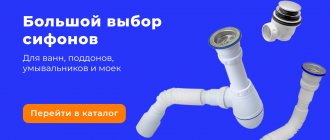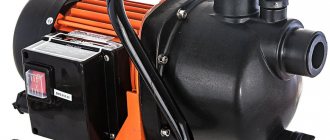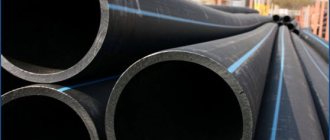The principle of measuring wastewater flow in an open channel.
Fluid flow (Q) measurement in a pipeline or channel cannot be performed directly.
To calculate it, the formula Q=Ṽ*A is used, where A is the cross-sectional area of the flow, and Ṽ is its average speed. In this case, the main and difficult task is the correct determination of the average speed Ṽ, since the cross-sectional area A is determined based on the shape of the channel (which can be taken from construction documentation, or measured when creating a metering unit) and the flow level, the measurement of which can be carried out in various ways and , as a rule, does not pose a problem.
Selecting the type of flow meter for a wastewater metering unit.
To determine the applicability of the above systems in certain conditions, we will consider their main advantages and disadvantages.
(1) Radar non-contact waste flow meters
The main advantage: simplicity and ease of installation and maintenance, which are determined by the fact that the non-contact sensor is located above the surface of the water and does not come into contact with the drain. The device measures the speed of surface runoff, which is a significant advantage compared to just a level gauge.
However, the low distribution of these systems today both in Europe and in Russia, as well as a sufficient number of negative reviews, suggests that they also have disadvantages. The main disadvantage is the very high error in flow measurement, reaching up to 30% and even 50%. The large error is determined by the strong dependence of this measurement method on the state of the flow surface (from waves and ripples), as well as the lack of an unambiguous connection between the measured speed on the surface and the average speed, which determines the volumetric flow rate of the liquid. It is recommended to use radar flow meters only in cases where it is completely impossible to install more accurate (submersible) devices - Doppler or cross-correlation. In addition, radar flow meters are quite expensive today, and their use at commercial water metering sites with low flow rates is impractical.
(2) Flow meters for gravity channels based on level meters
In addition to the above-described disadvantages inherent in radar non-contact systems, when using level meters to determine flow, the problem of a complete lack of information about the flow rate is added.
Such devices can operate relatively adequately in the absence of backups. But guaranteeing the absence of backups is very problematic. If they are not even present at the time of installation of the equipment, they may appear unpredictably over time. Any incipient blockage or foreign object in the channel leads to the appearance of backwater. If a pipe from an enterprise discharges wastewater into the city sewer, and the collector operates in high-fill mode, backwater also occurs. In the presence of backwater, the error of this measurement method can reach hundreds of percent. If the water in the collector is stationary and the level remains high due to backwater, the error tends to infinity.
In addition, the use of ultrasonic level meters is impossible in the presence of foam, steam, fog, intense precipitation, large waves, etc.
The undoubted advantage of flow measurement systems based on level gauges is their low cost, as well as ease of installation and maintenance. It is recommended to use this method either for technological (non-commercial) needs, or for commercial metering on pipes and channels with low flow rates, when even a large instrument error does not lead to large financial losses.
(3) Doppler wastewater flowmeters
Submersible Doppler flow meters measure the speed of particles in a flow based on the Doppler effect (measuring the difference in frequencies of the emitted ultrasonic signal and the signal reflected from the moving particle).
The problem is that particles move at different speeds in different layers of the flow. Closer to the bottom or walls, particles move slower, closer to the surface - faster, on the surface again slower. The distribution of velocities depends on many factors, including the size and nature of bottom sediments, the roughness of the walls, the nature, speed and level of the flow, etc.
| Normal diagram of velocity distribution by flow levels | Velocity plot at the beginning of the rain | Velocity diagram for large bottom sediments |
Doppler sensors are unable to determine at what level the particles they measure are moving at. The average speed in this case is determined as the product of the measured speed and the calibration factor “K”.
Ṽ=Viz*K
In this case, the calibration coefficient is usually selected from tables depending on the material of the walls of the pipeline or channel, the time since the start of operation of the channel, etc. In this case, an essential assumption is already used. Or the coefficient is determined during the calibration process during installation. But, in this case, it must be borne in mind that the actual dependence of the average speed on the measured one is a nonlinear function of the speed and level, i.e. calibration performed with one hydraulic characteristics will not be correct with other characteristics. In addition, the readings of Doppler flow meters are strongly influenced by the level of pollution of the runoff (the number of suspended particles per unit volume). The Doppler measurement method provides significantly more accurate results than the use of level meters or non-contact radar flow meters, but its error in some cases can be 20-25%, with strict compliance with all the requirements of the operating manual (which is confirmed by a number of comparative tests). However, in some cases, depending on the specific hydraulic conditions, Doppler flow meters can provide good accuracy (2-5%).
(4) The use of electromagnetic and ultrasonic flow meters when converting free flow into pressure flow.
Converting the non-pressure operating mode of a pipeline to pressure mode is a fairly simple and beautiful solution for small-diameter pipes.
After installing a section of pipe bent upward in the well of a free-flow pipeline, the pipeline is completely filled and switches to pressure mode. Measuring flow in a pressure pipeline is a simpler and more mature task. This can be done with both ultrasonic sensors and electromagnetic flow meters, the error of which can be 0.5-1.0%. However, in some cases, with dirty drainage, blockages can form in the place where the pipe bends upward - as a result, the error due to deposits increases (in proportion to the growth of deposits) and after some time the unit becomes inoperable. Daily cleaning of the pipe at the metering point is unlikely to be acceptable to the user. In addition, this method is difficult to implement and quite expensive in large diameter pipes. It is usually used in pipes with a diameter of less than 300 mm.
(5) Cross-correlation metering devices
The cross-correlation method was developed and patented by Nivus GmbH in 2000. This method is sometimes confused with the Doppler method, although it is not directly related to it. The cross-correlation method does not analyze the change in signal frequency when reflected from moving particles, but compares ultrasonic photographs obtained with a frequency of 500 to 2000 units per second.
Based on comparisons of these ultrasonic photographs, the movement of particles in each layer of the flow per unit time is determined, i.e. the speed of movement of all layers of the flow is determined. In this way, the average velocity is accurately calculated from the obtained direct velocity measurements across the flow layers. In this case, neither preliminary calibration nor taking into account the wall roughness by entering tabular (theoretical) coefficients is required.
(6) Time-pulse flowmeters
This type of flowmeter is intended primarily for measurements in relatively clean flows, since the accuracy of their readings strongly depends on the homogeneity of the medium. This type of device is often used to measure the flow of clean drinking water or at water intakes. In terms of wastewater, they are usually used in the discharge channels of cooling circuits of industrial enterprises, as well as for purified water at the outlet of treatment facilities. Their advantage is the ability to measure very wide channels - up to 100 meters or more. Time-pulse flowmeters are produced with mortise or clamp-on sensors for pressure pipes, and for free-flow pipes - in the form of pipe or wedge-shaped sensors, or hemispheres.
What it is
The sewer meter is a flow meter. It is installed on the sewer pipeline in a gap or on the surface of the pipe. Considering the peculiarities of the system’s operation, the second option seems more reliable. A regular impeller inside the pipeline will cause a permanent blockage. Instead of calculating the volume of wastewater, there will be an obstacle to its passage.
Based on the principle of operation, flow meters are usually divided into two groups:
- determining flow rate based on the water level in the pipe;
- wastewater level and speed meters.
The first type of devices is intended for gravity (free-flow) collectors. The second is designed for use in pressure lines, as well as for controlling the volume of storm drains.
It is believed that the flow meter for sewerage will be beneficial mainly for residents of the private sector. They spend a lot of water on watering plants and other household needs. This liquid will not go down the drain, but you will have to pay for it. Sewage metering devices will allow you to accurately determine the amount of water discharge. It is estimated that the savings will be about 300-500 liters per week, but in practice this value may be much higher.
Owners of city apartments simply have nowhere to install meters, so for now it has been decided to stick to communal meters. The innovation will not affect owners of autonomous sewer systems, since they are not related to public lines.
Installation of submersible sensors for wastewater metering devices
If everything is quite clear with the installation of non-contact level sensors and radar flow meters (ease of installation is their main advantage, to the detriment of measurement accuracy), then the installation of submersible sensors often requires special technical solutions. In gravity pipes with a diameter of 200-800 mm, Doppler and cross-correlation sensors are installed, as a rule, on a spacer mounting ring, which ensures minimal installation time with reliable fixation.
In pipes with a diameter of over 800 mm, a plate with a sensor is attached to the pipeline wall. When installing in particularly dirty water, such as industrial or sewerage, you need to carefully monitor the laying and fixation of the cable, especially in the lower part of the pipe. In addition to the fact that a poorly fixed cable leads to the accumulation of hair, dirt and rags on it (with the possibility of subsequent clogging or tearing of the entire structure by the flow), it can dangle under the influence of the flow and fray when rubbing against the fastening structure. When attaching metal plates to the wall of a large-diameter pipe with screws, even the shape of the head of the fixing screws and many other technological details are of great importance.
A serious problem is the installation of submersible sensors in deep flows, especially when the flow speed is high and it is impossible to temporarily stop the flow. For this purpose, diving work or work at a minimum flow level (at night, etc.) can be used. However, there are also special technical solutions that make it possible not only to lower sensors into a deep stream, but also to remove them from there without the help of divers for verification and maintenance. The figures below show options for mounting sensors on metal structures that can be lowered into and removed from the channel.
In addition, sensors can be installed upside down on floats. This not only makes it easier to install sensors in deep channels, but also makes it possible to make accurate calculations with variable bottom sediments (in cases where bottom sediments depend on the amount of precipitation, for example), since the ultrasonic level sensor built into the sensor will measure the flow level from the surface to the actual bottom surface with sediments.
We can also mention the additional capabilities of cross-correlation flowmeters for measuring wide flows. This type of flowmeter allows you to connect several velocity sensors to the computer, located at the bottom of the channel, or at the bottom and on the walls of the channel and, due to this, obtain a velocity diagram not only along the flow depth, but also along the width. This ensures high measurement accuracy in wide channels.
Possible problems when using wastewater meters with submersible sensors
The most serious problem when using submersible sensors is the possibility of them losing their functionality as a result of contamination when working in a dirty sewer, or destruction due to the presence of rolling stones and other heavy objects in the flow. At the same time, Vodokanals of Russia take this problem especially seriously, because they consider sewer pipes in our country to be the dirtiest. But it is not so. Immersion sensors are used all over the world, not only in well-maintained pipes in Germany and Switzerland, but also in India and other countries where sewage systems are no cleaner than domestic ones.
The ultrasonic sensors used are specially designed for difficult working conditions and do not lose their functionality when silting occurs, since wet sludge transmits ultrasound well.
When covering the sensors with a layer of rags or material that is opaque to ultrasound, flow meters from leading manufacturers do not give incorrect readings, but signal an error and the need for cleaning. To reduce the likelihood of clogging, the sensors are usually installed not at the bottom (not at 6 o'clock), but with some offset (for example, at 4 o'clock or 5 o'clock).
Installation on a small elevation (on a special stand) and a number of other methods are also used to minimize problems caused by dirt.
To protect against rolling stones and other solid objects that can break the sensor body, specially shaped metal protection is used.
Another problematic task is measurement in flows that have a low level at some points in time. This results in water not covering the sensor and preventing speed measurements. The possibility of converting a free-flow flow into a pressure flow through the use of a pipe bent upward has already been described above. Small dams can also be used to raise the level. In this case, the flow remains free-flowing, but the level rises.
Why are there inaccuracies?
Metering devices can produce questionable data for various reasons. They can be either overestimated or underestimated. In the first case, this is extremely unprofitable for the owner of the meter. In the second case, the company will require an inspection.
Distortions in readings may occur for the following reasons:
- as a result of backwater of liquid in the pipe;
- there are blockages in the pipeline.
To exclude these causes, it is necessary to carefully inspect and, if necessary, clean the collector. Normal dirt on the flowmeter body can also cause incorrect readings.
Reasons why backups may occur:
- obstacles in front of the liquid that prevent it from moving further through the pipeline;
- garbage, various objects that clog the collector
- large pipe slope;
- the manifold is not inserted correctly into the main pipeline.
Inaccuracies may arise due to changes in pipe cross-section in different areas. This can happen due to siltation for the following reasons:
- the slope of the free-flow pipe is very small;
- a large amount of sand and various suspended particles have accumulated in the liquid;
- the walls of the pipe collapsed and groundwater, earth, and stones got in.
Areas that are heavily silted will need to be thoroughly cleaned. This is not always easy to do.
Sometimes it is necessary to survey large areas of sewer systems. Specialists can quickly and accurately determine the cause of siltation and blockages .
If there is any suspicion that the meter has begun to show incorrectly, it is necessary to clean the sewer.
Even better is to carry out preventive inspections to prevent costly plumbing work. As a result, this will ensure proper operation of the device and you will not have to pay for inflated volumes.
Review of the most popular models and manufacturers.
Among the flow meters certified and used in Russia, the following manufacturers can be noted: Cross-correlation devices are supplied by Nivus GmbH.
Doppler flowmeters are supplied by several foreign and a number of domestic companies; among foreign ones we can mention Nivus (OCM-F), ISCO, ADS, Hydreka (Mainstream); Domestic and Dnepr do not yet particularly recommend purchasing their Doppler flow meters, while to measure flow in open channels they recommend installing more conventional level meters from their production.
Radar non-contact flow meters with the function of measuring surface runoff velocity are offered by Nivus (OFR), FlowTronic (RavenEye), Hach (Flo-Dar). ISCO offers a non-contact laser flow meter.
Devices for converting gravity flow to pressure flow are offered by Nivus (Profiler), Flow-Tronic (Sewer Mag) and the domestic manufacturer Enrima (Stockmer). Time-pulse flowmeters for channels are offered by Nivus, Accusonic and Seba Hydrometrie.
Among the level gauges with a flow measurement function, the most popular manufacturers are Signur (Echo-R), Vzlet (RSL), Dnepr and many others. You can pay attention to the completely autonomous SonicSens level meters, which operate on batteries for three to five years and transmit information about the level and flow rate via GSM wireless communication channels.
US-800 Digital Interfaces
| Possible digital outputs from the US-800 electronic unit, versions 11, 13, 21, 23, 31, 33 | |
| Digital interface RS485 more details “RS485 option” | The RS485 digital interface can be used to network flow meters with subsequent connection to a remote PC, laptop or microprocessor device, for example, via a GSM modem (group or single connection to a RS485 GSM modem) or cable over a distance of up to 1000 meters (or more) when using RS485/RS485 repeaters), when using Enhernet adapters, it is possible to combine into an Ethernet network. For more details, see connection options Support for data transfer protocols via RS485: DCON, Modbus |
| The load capacity of the electronic unit allows you to combine up to 32 flow meters into one network segment. When using RS485/RS485 repeaters, the network can be expanded to 256 flow meters. | |
Prices for flow meters for wastewater.
Cross-correlation wastewater meters are the most accurate, reliable and stable flow meters available on the market today. But their price is higher than that of Doppler flow meters and, especially, level meters. If you are dealing with a small pipe, with a small flow, and if the annual water payments for this metering unit are significantly lower than the cost of a high-quality flow meter, then it may be more profitable for you to use a cheaper (albeit less accurate) system - a level meter or Doppler. At the same time, it is interesting that Nivus keeps quite reasonable prices for Doppler wastewater flowmeters, lower than most import suppliers, due to the fact that Nivus places the main emphasis on the most reliable cross-correlation systems. As for high-flow channels, the cross-correlation method is currently the best for them.
Today there is a fairly large selection of wastewater metering devices that differ in price and quality. And if you are faced with the task of buying a meter for non-pressure industrial, household or storm sewerage, or pipes and channels for water intake and spillway, then you can choose your own option for each application. At the same time, it is better to entrust the installation of wastewater metering units to specialists, since the accuracy of the readings and the duration of their operation largely depend on the correct installation of the devices.
- Sewage meter

